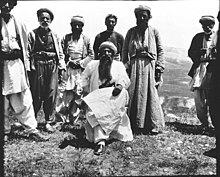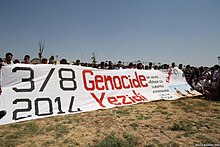
Duhok is a city in the Kurdistan Region of Iraq. It is the capital city of Duhok Governorate.

Bedir Khan Beg was the last Kurdish Mîr and mütesellim of the Emirate of Botan.

Sinjar is a town in the Sinjar District of the Nineveh Governorate in northern Iraq. It is located about five kilometers south of the Sinjar Mountains. Its population in 2013 was estimated at 88,023, and is predominantly Yazidi.

Lalish is a mountain valley and temple in Shekhan, Duhok Governorate in Iraqi Kurdistan. It is the holiest temple of the Yazidis. It is the location of the tomb of the Sheikh Adi ibn Musafir, a central figure of the Yazidi faith.

Bohtan was a medieval Kurdish principality in the Ottoman Empire centered on the town of Jazirah ibn 'Omar (modern Cizre also known as Cizîra Botan in southeastern Anatolia. The official religion of this principality was Yezidism in 14th century, although the rulers eventually converted to Islam, Bohtan still constituted the third major Yezidi enclave after Shekhan and Sinjar until 19th century.

The Qahtaniyah bombings occurred on August 14, 2007, when four coordinated suicide car bomb attacks detonated in the Yazidi towns of Til Ezer (al-Qahtaniyah) and Siba Sheikh Khidir (al-Jazirah), in northern Iraq.

Yazidis or Yezidis are a Kurdish-speaking endogamous religious group who are indigenous to Kurdistan, a geographical region in Western Asia that includes parts of Iraq, Syria, Turkey and Iran. The majority of Yazidis remaining in the Middle East today live in Iraq, primarily in the governorates of Nineveh and Duhok.
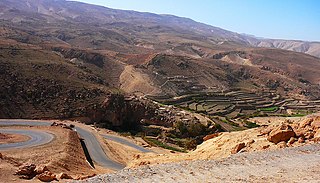
The Sinjar Mountains, are a 100-kilometre-long (62 mi) mountain range that runs east to west, rising above the surrounding alluvial steppe plains in northwestern Iraq to an elevation of 1,463 meters (4,800 ft). The highest segment of these mountains, about 75 km (47 mi) long, lies in the Nineveh Governorate. The western and lower segment of these mountains lies in Syria and is about 25 km (16 mi) long. The city of Sinjar is just south of the range. These mountains are regarded as sacred by the Yazidis.

Bashiqa is a town situated at the heart of the Nineveh plain, between Mosul and Sheikhan, on the edges of Mount Maqlub.
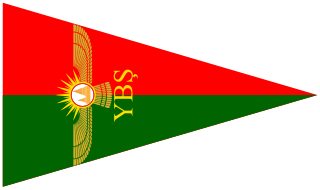
The Sinjar Resistance Units is a Yazidi militia formed in Iraq in 2007 to protect Yazidis in Iraq in the wake of attacks by Sunni Islamist insurgents. It is the second largest Yazidi militia, after the Êzîdxan Protection Force (HPÊ). However, it is much more active than the HPÊ in fighting against the Islamic State of Iraq and the Levant (ISIL).

The Sinjar District or the Shingal District is a district of the Nineveh Governorate. The district seat is the town of Sinjar. The district has two subdistricts, al-Shemal and al-Qayrawan. The district is one of two major population centers for Yazidis, the other being Shekhan District.

The Sinjar massacre marked the beginning of the genocide of Yazidis by ISIL, the killing and abduction of thousands of Yazidi men, women and children. It took place in August 2014 in Sinjar city and Sinjar District in Iraq's Nineveh Governorate and was perpetrated by the Islamic State of Iraq and the Levant (ISIL). The massacre began with ISIL attacking and capturing Sinjar and neighboring towns on 3 August, during its Northern Iraq offensive.
Between 1 and 15 August 2014, the Islamic State of Iraq and the Levant (ISIL) expanded territory in northern Iraq under their control. In the region north and west from Mosul, the Islamic State conquered Zumar, Sinjar, Wana, Mosul Dam, Qaraqosh, Tel Keppe, Batnaya and Kocho, and in the region south and east of Mosul the towns Bakhdida, Karamlish, Bartella and Makhmour
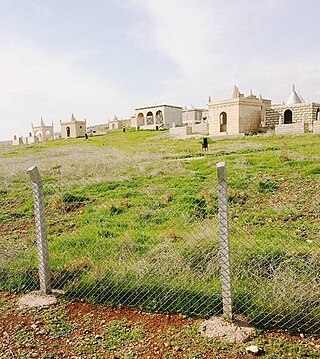
Yazidism in Turkey refers to adherents of Yazidism from Turkey, who remained in Turkey after the dissolution of the Ottoman Empire. The Yazidis living in Turkey during and after the second half of the 20th century gradually left for European countries. In the 1980s, there were 60,000 Yazidis situated in Beşiri, Kurtalan, Bismil, Midyat, Idil, Cizre, Nusaybin, Viranşehir, Suruç and Bozova. Today, these places are almost empty due to exodus to Europe which was provoked by political, religious and economic difficulties. Today only small number remain in villages around Midyat, Viranşehir, Çınar and Beşiri. According to the census of 2000, only 423 individuals adhering to Yazidism remained in the country.
The Ba'athist Arabization campaigns in northern Iraq were part of a large-scale effort in demographic engineering undertaken by the erstwhile Iraqi government, which had aimed to shift the country's population in a way that would render non-Arabs subjugated under Arab hegemony. While comprising the ethnic majority on a national scale, the Arab population is a regional minority in northern Iraq; this region of the country is where Iraqi ethnic minorities are concentrated. In order to Arabize the north, the government adopted a policy in line with settler colonialism, allotting land in the north to Arab settlers. The campaigns also involved ethnic cleansing, primarily targeting Kurds, but also Turkmen, Yazidis, Assyrians, Shabaks, Mandaeans, and Armenians, among others. In 1978 and 1979, 600 Kurdish villages were burned down and around 200,000 Kurds were deported to other parts of Iraq.

The November Sinjar offensive was a combination of operations of Kurdish Peshmerga, PKK, and Yezidi Kurd militias in November 2015, to recapture the city of Sinjar from the Islamic State of Iraq and the Levant. It resulted in a decisive victory for the Kurdish forces, who expelled the ISIL militants from Sinjar and regained control of Highway 47, which until then had served as the major supply route between the ISIL strongholds of Raqqa and Mosul.

A genocide of Yazidis by the Islamic State was carried out in the Sinjar area of northern Iraq in the mid-2010s. The genocide led to the expulsion and effective exile of the Yazidis. Thousands of Yazidi women and girls were forced into sexual slavery by ISIL, and thousands of Yazidi men were killed. About 5,000 Yazidi civilians were killed during what has been called a "forced conversion campaign" carried out by ISIL in Northern Iraq. The genocide began after the withdrawal of Iraqi forces and Peshmerga, which left the Yazidis defenseless.

Muhammad Pasha of Rawanduz was Kurdish Mir of the Soran Emirate (1813–1838). He led an unsuccessful attack against the Emirate of Botan of Bedir Khan Beg in 1834.
Ridwan or Redwan was a place in the Ottoman Empire that was inhabited by Yazidis.
Alphabetical index of articles about the Yazidis, and their history and culture.




